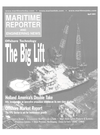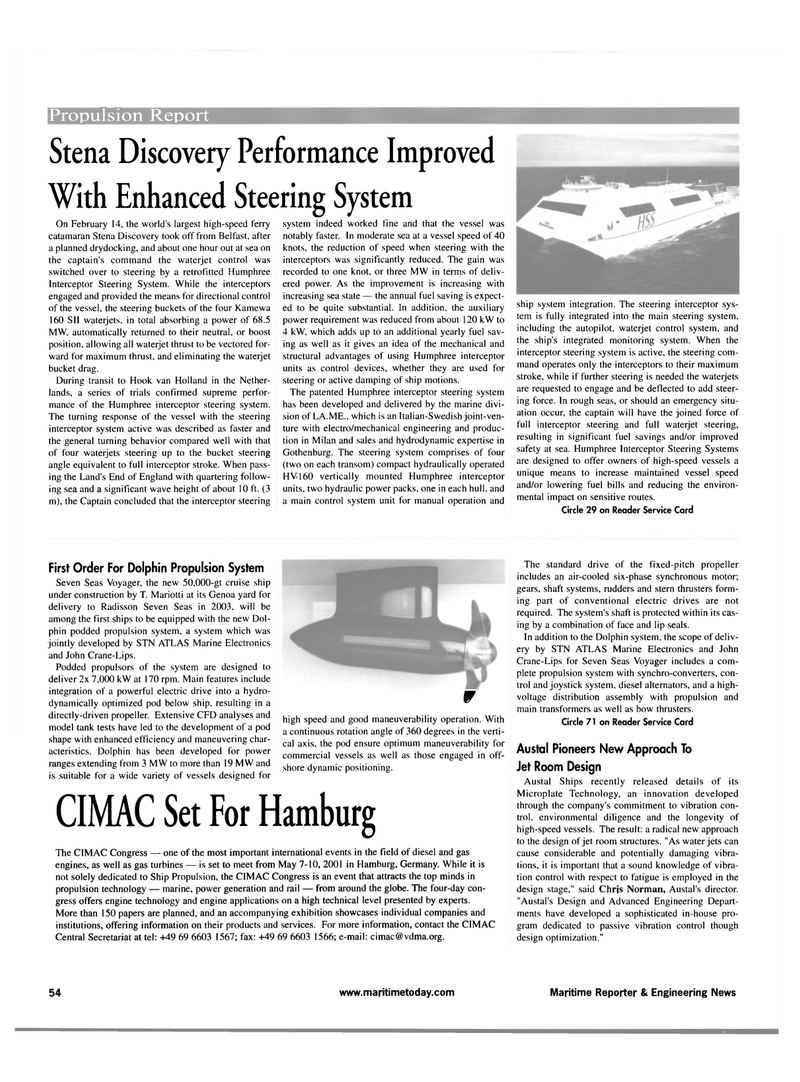
Page 54: of Maritime Reporter Magazine (April 2001)
Read this page in Pdf, Flash or Html5 edition of April 2001 Maritime Reporter Magazine
Propulsion Report
Stena Discovery Performance Improved
With Enhanced Steering System
On February 14, the world's largest high-speed ferry catamaran Stena Discovery took off from Belfast, after a planned drydocking, and about one hour out at sea on the captain's command the waterjet control was switched over to steering by a retrofitted Humphree
Interceptor Steering System. While the interceptors engaged and provided the means for directional control of the vessel, the steering buckets of the four Kamewa 160 SII waterjets. in total absorbing a power of 68.5
MW, automatically returned to their neutral, or boost position, allowing all waterjet thrust to be vectored for- ward for maximum thrust, and eliminating the waterjet bucket drag.
During transit to Hook van Holland in the Nether- lands, a series of trials confirmed supreme perfor- mance of the Humphree interceptor steering system.
The turning response of the vessel with the steering interceptor system active was described as faster and the general turning behavior compared well with that of four waterjets steering up to the bucket steering angle equivalent to full interceptor stroke. When pass- ing the Land's End of England with quartering follow- ing sea and a significant wave height of about 10 ft. (3 m), the Captain concluded that the interceptor steering system indeed worked fine and that the vessel was notably faster. In moderate sea at a vessel speed of 40 knots, the reduction of speed when steering with the interceptors was significantly reduced. The gain was recorded to one knot, or three MW in terms of deliv- ered power. As the improvement is increasing with increasing sea state — the annual fuel saving is expect- ed to be quite substantial. In addition, the auxiliary power requirement was reduced from about 120 kW to 4 kW, which adds up to an additional yearly fuel sav- ing as well as it gives an idea of the mechanical and structural advantages of using Humphree interceptor units as control devices, whether they are used for steering or active damping of ship motions.
The patented Humphree interceptor steering system has been developed and delivered by the marine divi- sion of LA.ME., which is an Italian-Swedish joint-ven- ture with electro/mechanical engineering and produc- tion in Milan and sales and hydrodynamic expertise in
Gothenburg. The steering system comprises of four (two on each transom) compact hydraulically operated
HV160 vertically mounted Humphree interceptor units, two hydraulic power packs, one in each hull, and a main control system unit for manual operation and
First Order For Dolphin Propulsion System
Seven Seas Voyager, the new 50,000-gt cruise ship under construction by T. Mariotti at its Genoa yard for delivery to Radisson Seven Seas in 2003, will be among the first ships to be equipped with the new Dol- phin podded propulsion system, a system which was jointly developed by STN ATLAS Marine Electronics and John Crane-Lips.
Podded propulsors of the system are designed to deliver 2x 7,000 kW at 170 rpm. Main features include integration of a powerful electric drive into a hydro- dynamically optimized pod below ship, resulting in a directly-driven propeller. Extensive CFD analyses and model tank tests have led to the development of a pod shape with enhanced efficiency and maneuvering char- acteristics. Dolphin has been developed for power ranges extending from 3 MW to more than 19 MW and is suitable for a wide variety of vessels designed for w high speed and good maneuverability operation. With a continuous rotation angle of 360 degrees in the verti- cal axis, the pod ensure optimum maneuverability for commercial vessels as well as those engaged in off- shore dynamic positioning. ship system integration. The steering interceptor sys- tem is fully integrated into the main steering system, including the autopilot, waterjet control system, and the ship's integrated monitoring system. When the interceptor steering system is active, the steering com- mand operates only the interceptors to their maximum stroke, while if further steering is needed the waterjets are requested to engage and be deflected to add steer- ing force. In rough seas, or should an emergency situ- ation occur, the captain will have the joined force of full interceptor steering and full waterjet steering, resulting in significant fuel savings and/or improved safety at sea. Humphree Interceptor Steering Systems are designed to offer owners of high-speed vessels a unique means to increase maintained vessel speed and/or lowering fuel bills and reducing the environ- mental impact on sensitive routes.
Circle 29 on Reader Service Card
The standard drive of the fixed-pitch propeller includes an air-cooled six-phase synchronous motor; gears, shaft systems, rudders and stern thrusters form- ing part of conventional electric drives are not required. The system's shaft is protected within its cas- ing by a combination of face and lip seals.
In addition to the Dolphin system, the scope of deliv- ery by STN ATLAS Marine Electronics and John
Crane-Lips for Seven Seas Voyager includes a com- plete propulsion system with synchro-converters, con- trol and joystick system, diesel alternators, and a high- voltage distribution assembly with propulsion and main transformers as well as bow thrusters.
Circle 71 on Reader Service Card
Austal Pioneers New Approach To
Jet Room Design
Austal Ships recently released details of its
Microplate Technology, an innovation developed through the company's commitment to vibration con- trol, environmental diligence and the longevity of high-speed vessels. The result: a radical new approach to the design of jet room structures. "As waterjets can cause considerable and potentially damaging vibra- tions, it is important that a sound knowledge of vibra- tion control with respect to fatigue is employed in the design stage," said Chris Norman, Austal's director. "Austal's Design and Advanced Engineering Depart- ments have developed a sophisticated in-house pro- gram dedicated to passive vibration control though design optimization."
CIMAC Set For Hamburg
The CIMAC Congress — one of the most important international events in the field of diesel and gas engines, as well as gas turbines — is set to meet from May 7-10, 2001 in Hamburg, Germany. While it is not solely dedicated to Ship Propulsion, the CIMAC Congress is an event that attracts the top minds in propulsion technology — marine, power generation and rail — from around the globe. The four-day con- gress offers engine technology and engine applications on a high technical level presented by experts.
More than 150 papers are planned, and an accompanying exhibition showcases individual companies and institutions, offering information on their products and services. For more information, contact the CIMAC
Central Secretariat at tel: +49 69 6603 1567; fax: +49 69 6603 1566; e-mail: [email protected]. 54 www.maritimetoday.com Maritime Reporter & Engineering News

 53
53

 55
55
